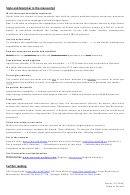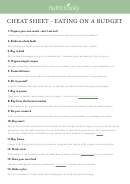Cheat Sheet For Writing A Scientific Manuscript
ADVERTISEMENT
Cheat sheet for writing a scientific manuscript
Structure of the manuscript
Each sentence should make a clear statement or ask a clear question. Give specific examples.
Bad: To overcome the given limitations of standard VMI, one can modify the set-up in several ways: ...
Better: Traditional implementations of VMI can only detect low-velocity particles. Several modifictions
are required to detect high-velocity (> 1 keV) ions: ...
Each paragraph should address one topic or question. Every paragraph should make sense without
the need to read the complete manuscript. You should be able to define a subject for each
paragraph.
E.g.: "Ionization of matter with XUV radiation", "Spectrometers to characterize ionized particles",
"Velocity map imaging spectrometers", ...
Each Figure Illustrates an important premise, result, or model. The reader should quickly grasp the
content of the figure and figure caption without reading the complete manuscript. Make sure all
elements and font are large enough (hold your graph at 1 m distance, now you know what the
shortsighted referee will see.) 'A picture is worth a thousand words.' (is yours?)
Each section of the text fulfills a well-defined role
Abstract (write this at last)
The abstract should accurately reflect the content of the paper.
Introduction (write this after the Discussion)
Define the question you will address in the text.
Why is this question scientifically relevant, why should the reader be interested?
What has been done to address the question in the past? (Avoid discussing marginally relevant
literature.)
Describe related work that will help you answer your question.
Experimental / Theoretical (write this first)
Describe the experiment or theoretical work you performed. A skilled reader should be able to
reproduce your work based on the information you give -- write no more and no less.
Results (write this after the Experimental / Theoretical section)
Describe the experimental or theoretical results. If multiple experiments are presented, then clarify
the differences between them. Describe the statistical analysis of the data. Do not dilute your results
with conjecture or premature interpretation.
Discussion (write this after the Results section)
Explain how the data answers your scientific question. (If you have not yet identified your scientific
question, then take a mental step back to identify what is new in your data and how it relates to the
existing knowledge.) Refer to the literature to show whether your results agree, disagree, or
complement published work. Give a model that explains your results and other published data.
Collect all literature you require to interpret and model your data: you should introduce this
literature in the Introduction. Now you can go and write the Introduction.
Conclusion (write this after the Discussion)
Consolidate the discussed results, judge their significance and speculate on future directions. Do not
write Conclusions unless the Discussion is excessively long or, for other reasons, unintelligible.
ADVERTISEMENT
0 votes
Related Articles
Related forms
Related Categories
Parent category: Education
 1
1 2
2








